Arabic calligraphy
Arabic Calligraphy is the artistic practice of handwriting and calligraphy based on the Arabic alphabet. It is known in Arabic as khatt (Arabic: خط), derived from the word 'line', 'design', or 'construction'.[1][2] Kufic is the oldest form of the Arabic script.
| Calligraphy |
|---|
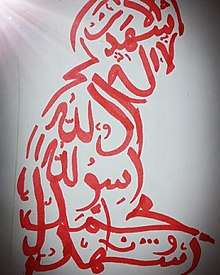
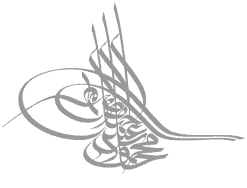
From an artistic point of view, Arabic calligraphy has been known and appreciated for its diversity and great potential for development. In fact, it has been linked in the Arabic civilization to various fields such as religion, art, architecture, education and craftsmanship, which in return have played an important role in its advancement.[3]
Although most Islamic calligraphy is in Arabic and most Arabic calligraphy is Islamic, the two are not identical. Coptic or other Christian manuscripts in Arabic, for example, have made use of calligraphy. Likewise, there is Islamic calligraphy in Persian or the historic Ottoman language.
Implements
The pens used for Arabic calligraphy vary from Latin calligraphy. The tools used for calligraphy are different assortments of pens and calligraphy ink. The most common calligraphy pen used is Qalam.
Khamish Pen
The Khamish Pen also known as a reed pen is used by Arab, Turkish, and Iranian calligraphers. The reed of the pen is grown along rivers. Although this pen has been used for over 500 years, preparing the pen is a lengthy process.
Bamboo pen
Bamboo pens are one of the oldest pens used for calligraphy. The edge of bamboo pens allow the performance of calligraphy to be in full movement.
Java pen
The Java pen is known for the tool's hardness and ability to create sharp edges. The pen is good to use for small scripts.
Handam pen
The Handam pen consists of the same strength that the Java pen has. The pen is good to use for all kinds of scripts.
Celi pen
The Celi pen is used for large writing in Arabic Calligraphy. These pens are made from hardwood and cut and drilled.
Arabic alphabet
The Arabic alphabet is known to be used by one of the most widely used languages in the world. Many scholars believe that the alphabet was created around the 4th century CE.[4] The alphabet consists of 28 letters written from right to left. Each letter can be written in four ways, depending on where the letter is placed in a sentence. These four locations are also known as initial, medial, final and isolated.
Popular scripts
The two most popular scripts used for Arabic calligraphy are Kufic and Naskh. Kūfic was derived from Iraq and initially used for inscription on stone and metal. Naskhī originated from Mecca and Medina. The script is used as a cursive script, for example on papyrus and paper.
Other scripts
The Thuluth and Nasta'liq and Diwani script are other scripts used for Arabic scripting.
The Thuluth script used during the medieval times is known as one of the oldest scripts to exist. The script was used on mosques and for Quranic text due to the appearance of the text.
The Nasta'liq script is used more for Persian than Arabic scripting. Because of the upward slant to the left,[5] the script is seen as different than the other scripts. The cursive look creates an elegant look when creating.
The Diwani Script was created during the Ottoman era. The lining and lettering of this script creates a sense of closeness when writing. Due to this reason, it's difficult to read since the letters intertwine.[5]
Table of basic letters
| Common | Maghrebian | Letter name (Classical pronunciation) |
Letter name in Arabic script |
Trans- literation |
Value in Literary Arabic (IPA) | Closest English equivalent in pronunciation | Contextual forms | Isolated form | |||||
|---|---|---|---|---|---|---|---|---|---|---|---|---|---|
| ʾAbjadī | Hijāʾī | ʾAbjadī | Hijāʾī | Final | Medial | Initial | |||||||
| 1. | 1. | 1. | 1. | ʾalif
(ʾelif) |
أَلِف | ā / ʾ
(also â ) |
various, including /aː/[lower-alpha 1] |
car, cat | ـا | ا | |||
| 2. | 2. | 2. | 2. | bāʾ
(baaʾ) |
بَاء | b | /b/[lower-alpha 2] | barn | ـب | ـبـ | بـ | ب | |
| 22. | 3. | 22. | 3. | tāʾ | تَاء | t | /t/ | stick | ـت | ـتـ | تـ | ت | |
| 23. | 4. | 23. | 4. | thāʾ | ثَاء | th
(also ṯ ) |
/θ/ | think, thumb | ـث | ـثـ | ثـ | ث | |
| 3. | 5. | 3. | 5. | jīm | جِيم | j
(also ǧ ) |
/d͡ʒ/[lower-alpha 2][lower-alpha 3] | Jim, gym | ـج | ـجـ | جـ | ج | |
| 8. | 6. | 8. | 6. | ḥāʾ | حَاء | ḥ
(also ḩ ) |
/ħ/ | no equivalent
("guttural" h, may be approximated as heart) |
ـح | ـحـ | حـ | ح | |
| 24. | 7. | 24. | 7. | khāʾ | خَاء | kh
(also ḫ, ḵ, ẖ ) |
/x/ | loch; German Bach | ـخ | ـخـ | خـ | خ | |
| 4. | 8. | 4. | 8. | dāl | دَال | d | /d/ | dear | ـد | د | |||
| 25. | 9. | 25. | 9. | dhāl | ذَال | dh
(also ḏ ) |
/ð/ | that, them, though | ـذ | ذ | |||
| 20. | 10. | 20. | 10. | rāʾ | رَاء | r | /r/ | rap | ـر | ر | |||
| 7. | 11. | 7. | 11. | zāy / zayn | زَاي | z | /z/ | zebra | ـز | ز | |||
| 15. | 12. | 21. | 24. | sīn | سِين | s | /s/ | sin | ـس | ـسـ | سـ | س | |
| 21. | 13. | 28. | 25. | shīn | شِين | sh
(also š ) |
/ʃ/ | shin | ـش | ـشـ | شـ | ش | |
| 18. | 14. | 15. | 18. | ṣād | صَاد | ṣ
(also ş ) |
/sˤ/ | swarm, bass | ـص | ـصـ | صـ | ص | |
| 26. | 15. | 18. | 19. | ḍād | ضَاد | ḍ
(also ḑ ) |
/dˤ/ | dwarf | ـض | ـضـ | ضـ | ض | |
| 9. | 16. | 9. | 12. | ṭāʾ | طَاء | ṭ
(also ţ ) |
/tˤ/ | star | ـط | ـطـ | طـ | ط | |
| 27. | 17. | 26. | 13. | ẓāʾ | ظَاء | ẓ
(also z̧ ) |
/ðˤ/ | buzzword | ـظ | ـظـ | ظـ | ظ | |
| 16. | 18. | 16. | 20. | ʿayn | عَيْن | ʿ | /ʕ/ | no equivalent
("guttural" voiced h; similar to ḥāʾ above) |
ـع | ـعـ | عـ | ع | |
| 28. | 19. | 27. | 21. | ghayn | غَيْن | gh
(also ġ, ḡ ) |
/ɣ/[lower-alpha 2] | Spanish higo | ـغ | ـغـ | غـ | غ | |
| 17. | 20. | 17. | 22. | fāʾ | فَاء | f | /f/[lower-alpha 2] | far | ـف | ـفـ | فـ | ف[lower-alpha 4] | |
| 19. | 21. | 19. | 23. | qāf | قَاف | q | /q/[lower-alpha 2] | equal | ـق | ـقـ | قـ | ق[lower-alpha 4] | |
| 11. | 22. | 11. | 14. | kāf | كَاف | k | /k/[lower-alpha 2] | key, cap | ـك | ـكـ | كـ | ك | |
| 12. | 23. | 12. | 15. | lām | لاَم | l | /l/ | lamp | ـل | ـلـ | لـ | ل | |
| 13. | 24. | 13. | 16. | mīm | مِيم | m | /m/ | me | ـم | ـمـ | مـ | م | |
| 14. | 25. | 14. | 17. | nūn | نُون | n | /n/ | nun | ـن | ـنـ | نـ | ن | |
| 5. | 26. | 5. | 26. | hāʾ | هَاء | h | /h/ | hat | ـه | ـهـ | هـ | ه | |
| 6. | 27. | 6. | 27. | wāw | وَاو | w / ū | /w/, /uː/[lower-alpha 2] | we | ـو | و | |||
| 10. | 28. | 10. | 28. | yāʾ | يَاء | y / ī | /j/, /iː/[lower-alpha 2] | yacht, meet | ـي | ـيـ | يـ | ي[lower-alpha 4] | |
| (not counted as alphabet but plays an important role in Arabic grammar and lexicon, including indication [denoting most irregular female nouns] and spelling) | hamzah | هَمْزة | ʾ | /ʔ/ | uh–oh
(aka "glottal stop") |
ء
(used mainly in medial and final position, which is an unlinked letter) | |||||||
| ʾalif hamzah | أَلِف هَمْزة | ـأ | أ | ||||||||||
| ـإ | إ | ||||||||||||
| wāw hamzah | وَاو هَمْزة | ـؤ | ؤ | ||||||||||
| yāʾ hamzah | يَاء هَمْزة | ـئ | ـئـ | ئـ | ئ | ||||||||
| ʾalif maddah | أَلِف مَدَّة | ʾā | /ʔaː/ | ـآ | آ | ||||||||

Notes
- Alif can represent many phonemes. See the section on ʾalif.
- See the section on non-native letters and sounds; the letters ⟨ك⟩ ,⟨ق⟩ ,⟨غ⟩ ,⟨ج⟩ are sometimes used to transcribe the phoneme /g/ in loanwords, ⟨ب⟩ to transcribe /p/ and ⟨ف⟩ to transcribe /v/. Likewise the letters ⟨و⟩ and ⟨ي⟩ are used to transcribe the vowels /oː/ and /eː/ respectively in loanwords and dialects.
- ج is pronounced differently depending on the region. See Arabic phonology#Consonants.
- See the section on regional variations in letter form.
List of calligraphers
Some classical calligraphers:
- Medieval
- Ibn Muqla (d. 939/940)
- Ibn al-Bawwab (d. 1022)
- Fakhr-un-Nisa (12th century)
- Ottoman era
- Shaykh Hamdullah (1436–1520)
- Hamid Aytaç (1891-1982)
- Seyyid Kasim Gubari (d. 1624)
- Hâfiz Osman (1642–1698)
- Mustafa Râkim (1757–1826)
- Mehmed Shevki Efendi (1829–1887)
- Contemporary
- Hasan ÇELEBİ (b. 1937), Turkey
- Ali Adjalli (b. 1939), Iran
- Wijdan Ali (b. 1939), Jordan
- Hashem Muhammad al-Baghdadi, Iraq
- Everitte Barbee (b. 1988), United States of America
- Mohammad Hosni Syria
- Shakkir Hassan Al Sa'id (1925-2004) in Iraq
- Madiha Omar Iraqi-American
- Hassan Massoudy Iraqi-French (b. 1944)
- Sadequain Naqqash (1930-1987), Pakistan
- Ibrahim el-Salahi (b. 1930), Sudan
- Mouneer Al-Shaarani (b. 1952), Syria
- Mahmoud Taha (b. 1942), Jordan
- Mohamed Zakariya (b. 1942), United States of America
- Uthman Taha (b. 1934), Syria
Legacy
Typography
Arabic calligraphy serves as a major source of inspiration for Arabic typography. For example, the Amiri typeface is inspired by the Naskh script used at the Amiri Press in Cairo.[7]
The shift from Arabic calligraphy to Arabic typography presents technical challenges, as Arabic is essentially a cursive script with contextual shapes.
Art
EL Seed, a French-Tunisian graffiti artist, makes use of Arabic calligraphy in his various art projects, in a style called calligraffiti.[8]
The Hurufiyya (الحروفية letters) movement, since its beginnings in the early 20th century, uses the artistic manipulation of Arabic calligraphy and typography in abstraction.[9]
Taking Shape: Abstraction From the Arab World, 1950s-1980s, a 2020 installation at New York University's Grey Art Gallery, explored how Arabic calligraphy, with its ancient presence in visual art, influenced abstract art in the Arab world.[10] For Madiha Omar, the Arabic alphabet was a means of expressing a secular identity and appropriating Western painting, while Omar El-Nagdi explored the inherent divinity of Arabic calligraphy.[10]
Modern examples
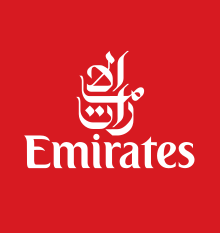 The Emirates logo is written in traditional Arabic calligraphy
The Emirates logo is written in traditional Arabic calligraphy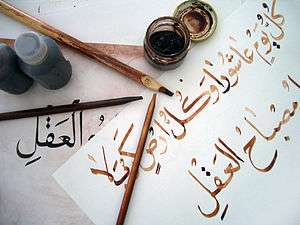
See also
References
- Julia Kaestle (10 July 2010). "Arabic calligraphy as a typographic exercise".
- Stefan Widany (June 2011). The History of Arabic Calligraphy: An Essay on Its Greatest Artists and Its Development. GRIN Verlag. ISBN 978-3-640-93875-9.
- Afā, ʻUmar.; افا، عمر. (2007). al-Khaṭṭ al-Maghribī : tārīkh wa-wāqiʻ wa-āfāq. Maghrāwī, Muḥammad., مغراوي، محمد. (al-Ṭabʻah 1 ed.). al-Dār al-Bayḍāʼ: Wizārat al-Awqāf wa-al-Shuʼūn al-Islāmīyah. ISBN 978-9981-59-129-5. OCLC 191880956.
- "Arabic alphabet | Chart, Letters, & Calligraphy".
- "Arabic Writing and Scripts: A Brief Guide | Shutterstock". 24 July 2014.
- Islamic calligraphy
- Hosny, Khaled (2012). "The Amiri typeface" (PDF). TUGBoat. 33: 12.
- PopTech (2011), eL Seed: The Art of Calligraffiti, retrieved 2020-02-24
- "NYU Grey Art Gallery Spotlights Pioneers of Arab Art". 2020-02-07. Retrieved 2020-02-25.
- Heinrich, Will (2020-02-20). "How the Arabic Alphabet Inspired Abstract Art". The New York Times. ISSN 0362-4331. Retrieved 2020-02-24.
External links

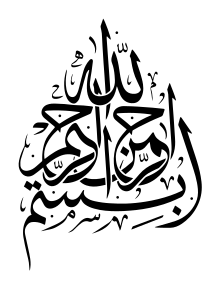
.jpeg)